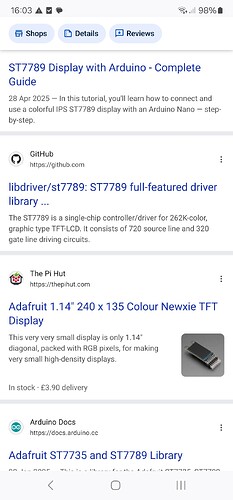I don’t understand – you’re not using PicoSDK or existing code from clockworkpi (as a reference at least)?
Yes it will help you. For more information, though, you should look at an actual ST7365P driver. I recommend you look at the driver in extra/common/st7365p_8_common.fs in the picocalc-devel branch of the zeptoforth source tree. Note that this driver uses an RGB332 framebuffer which it translates when it updates the display to RGB565.
For what it’s worth, we’re actually using ST7796S (in portrait mode) for PicoMite/WebMite. that display type was added to the final release of upstream PicoMite and we found the display updates were faster than using the previous display type so I switched to that.
From what I’ve read, it sounds like there are a ton of very similar displays that are all copies of each other and will mostly work with the same code, though some have certain features lacking in others, and they might actually work better if you can figure out what type of display it is and use a driver meant for that, though it will probably work with some that are “close enough”.
I’m not sure anyone actually knows what the deisplay type is on the PicoCalc, including Clockwork themselves. ![]()
Watch out though ─ someone tried to use my SSD1306 driver for zeptoforth with the CH1116, which is supposed to be largely compatible with the SSD1309, which in turn is supposed to be largely compatible with the SSD1306, and it largely did not work (it displayed as a horizontal band of correct pixels across the screen with the rest of the screen being garbage). And this was not just an issue with my driver, because I had read about someone else having the same issue with the CH1116 using a “compatible” driver for the SSD1309. So be aware that just because two things are “mostly” compatible does not mean that they are truly compatible.
So what display does the PicoCalc actually use?
We don’t know the actual part number, but it’s supposed to be close to ILI9488 and ST7365. There is an example in C here: Hello World Example | clockworkpi/PicoCalc | DeepWiki
edit: I mean here: PicoCalc/Code/picocalc_helloworld at master · clockworkpi/PicoCalc · GitHub
Yeah, I will check it out, but I also need to work on my kernel boot up too. Thanks.
How can I edit this thread, and it’s title?
Ok HELP NEEDED
I am looking for help on initializing and making a simple black and white text display system for the PicoCalc’s display.
If you have some help, please feel free!
W-What? Like text input and displaying it?
I think i got it working, but i need some safe way to test it.
Disclaimer!!!
I have now decided, that to use my OS, you MUST have a board with WiFi capabilities. (preferably the Pico2w)
Why are you requiring this?
wifi compatibility will be needed for updates, app library, search engine, etc.
Thats a lot of requirements for a “small” os. You’re going to run into sram problems soon.
You are getting way ahead of yourself here, TBH. You plan on your OS fitting in 64K of SRAM, yet you also plan on it having updates over the net, a net-based app library, a search engine? I always thought that zeptoforth was huge by microcontroller standards, yet even when zeptoIP is installed it does not attempt to do all those things.
scrap search engine idea for now (a future project hopefully) I want updates over net and a net-based app library.
^ this is unless there is a non wifi way to update and app library browse without having picocalc plugged into anything, or anything like that.
Reading your roadmap, you want to target the experimented users and nerds BUT limiting what apps can be used on your OS? It’s quite contentious.
Nerds want the freedom to use the system as they see fit.
If necessary, you can add certification signature for certain selected apps, similar to a ‘seal of quality’.
As a dev, I don’t want to use a system which hinders me (probably why I’m on linux uhuh…)
You can also use licences to legally protect your own code. For open source, I often use MIT or GPL depending on whether I want to ‘force’ the open source aspect of a project or not.
And if it’s really a project that could lead to a potential market, or if I want to remain the sole decision-maker regarding its development, then I keep it closed source. Obviously, this means that I’m the only one (or part of a small committee) developing it, so I can’t benefit from the community.
That’s the deal!
